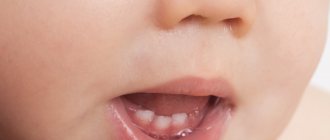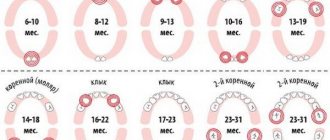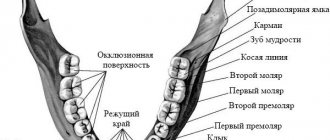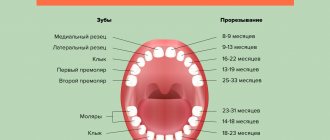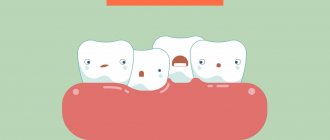20.11.2019
The first thing that parents should understand is that children’s development is always individual, so the question of whether teeth can be cut at 3 (three) months can be answered unequivocally in the affirmative. Don’t be alarmed if by this period of your child’s life there are signs such as restlessness, moodiness and loss of appetite, perhaps it’s time to buy a teether and be patient. Let's take a closer look at how to react to teething at the age of three months, what you should pay attention to, and what is considered completely normal at this stage of a child's development.
Teething sequence
Of course, we will talk about the standards according to which the optimal time and order of appearance of the first molars is determined. But don’t be upset if the baby’s personal schedule is behind or in a hurry in relation to this “schedule”. The discrepancy may well reach six months in one direction or the other, so if teeth are already making themselves felt at 3 (three) months, this should not be a cause for concern.
There is the following scheme for the eruption of primary molars:
- 5–7 months - a pair of lower frontal incisors;
- 8–10 months - upper front incisors;
- 10–12 months - a pair of lateral incisors on the upper jaw;
- 11–14 months - lower lateral incisors;
- 12–15 months - first the upper first molars, and then the lower ones;
- 16–23 months - upper, then lower canines;
- 24–30 months - upper, lower second molars.
If the frontal incisors emerge at three months, this is normal, but make sure that the first pair is formed first, and only then, for example, one of the lateral incisors. It is important to immediately rule out pathology in order to take the necessary measures in time.
When is there cause for concern?
After the appearance of the first long-awaited tooth, it is recommended to consult a pediatric dentist. In some cases, the child requires urgent medical care, and a visit to the clinic cannot be postponed. The following deviations are cause for concern:
- the teeth are cut crookedly, as a result the rows are broken;
- tooth growth began not from the incisors, but from the canines or molars;
- high temperature that persists for several days (unless it is caused by ARVI, influenza or other disease);
- diarrhea several times a day for 2–4 days (the same applies to vomiting).
Picture of the appearance of the first molars
Remember, the main thing is that the first teeth erupt before one year. At the same time, do not expect that the process itself will proceed according to the textbook - some children tolerate it easily and almost unnoticeably, others experience intense discomfort.
Sometimes teeth at 3 (three) months begin to manifest themselves very seriously, for example, tissue soreness, refusal to eat and high fever. A runny nose and vomiting are possible as a result of copious discharge.
Regarding the order of eruption and what symptoms appear and how easy or difficult the process itself is, the genetic factor is often of great importance here. Ask how everything went for you, and you can compare the picture of manifestations and draw certain conclusions for the future.
How long does it take for first molars to erupt?
When a child has already lost several teeth, parents have an idea of the duration of the process, but when the very first one appears, it is still difficult to talk about it. The first symptoms begin to appear about a month before actual eruption. For some the duration is a month, for others it is two weeks, everything is very individual.
This can also be used to judge when the baby will have all his milk teeth (20 molars in total). Early teething means that the baby will most likely acquire a whole set of hard formations by the age of two. In such children, new molars appear almost every month and are not accompanied by serious difficulties. For others, this same set is formed only by the age of 3.5, which is also normal.
Factors affecting tooth growth
The speed of formation of a mixed bite depends on several circumstances:
- baby's genotype;
- performance of the thyroid gland;
- gender;
- severe infectious and viral diseases suffered in the past;
- duration of natural feeding;
- the presence of congenital diseases.
You also need to monitor the period of eruption of molars. They should come out to the surface of the gums only after the milk unit falls out. Otherwise, a mandatory visit to the dentist will be required. Early loss of milk elements is also undesirable, as this negatively affects the proportions of the baby’s jaw and his bite in the future.
Signs of teething
You can understand that the first molar will soon come out by the following signs - the gums begin to swell and hurt greatly, which is accompanied by increased salivation. In this case, a similar picture can begin several months before the actual appearance of the teeth themselves. Sleep becomes restless, the child is capricious, due to severe discomfort, children refuse some meals, and an irresistible urge to put various objects in their mouth appears.
Once teething enters the active stage, you will notice a thin white line on the gum or a whitish protrusion. If you lightly tap the exposed teeth with a teaspoon, you will hear a slight clicking sound, some parents do this, but if you decide to do this test, do it very carefully.
How to correctly distinguish between symptoms
Some signs characteristic of the onset of the appearance of molars in children often overlap with the symptoms of infectious diseases. Therefore, if you have any doubts about this, it is better to seek advice from a specialist.
Pay attention to the temperature - it can rise to 38.5–39 degrees and stay for two days, this is normal. Paracetamol in small quantities is suitable for knocking it down, but if after this period the indicators do not decrease, you should not hesitate to go to the doctor.
Watery diarrhea also often occurs due to excessive salivation; normally, this repeats up to 2-3 times a day. If this period is exceeded and blood inclusions appear, there is already a reason to make an appointment with a specialist.
Regarding the runny nose, clear discharge that lasts 3-4 days does not cause concern; it is enough for parents to clear the sinuses of it in a timely manner.
If this period is exceeded, and the snot becomes whitish or greenish, do not hesitate to go to the doctor. The same applies to a cough, if it lasts more than two days and is accompanied by sputum, consultation is needed.
Remedies for pain relief in children
It is painful for parents to see their child in pain. You can help him get some relief with these remedies.
Simple tricks
Often, pain in the gums is relieved by applying gentle pressure to them. Therefore, many experts advise gently rubbing the gums with a clean finger or letting the child bite on a clean cloth.
If pain is causing feeding problems, sometimes a different shaped nipple or using a cup can reduce discomfort and improve feeding.
Cold
Cold objects can also help reduce inflammation. Using special teething rings can be helpful. Experienced parents have found that using a cool, damp sponge, a cold pacifier, a spoon, or frozen bananas can be effective in reducing discomfort.
Use of painkillers
There is controversy surrounding the use of these products during teething:
- Although some parents approve of topical medications, studies have not always shown their benefit. In May 2011, the FDA issued a warning to avoid topical medications containing an anesthetic called benzocaine. Benzocaine is the main ingredient found in many over-the-counter gels and sprays. The FDA warning indicates a link to a rare but extremely dangerous complication called methemoglobinemia. In this condition, the ability of red blood cells to deliver oxygen throughout the body is significantly limited, which can lead to serious consequences and even death. Children with methemoglobinemia experience pallor, shortness of breath, and increased heart rate. This reaction may occur on first use or after several exposures to benzocaine. A child with these symptoms should be taken to the emergency department of the nearest hospital;
- Systemic medications such as paracetamol or ibuprofen will also help with pain. Check with your pediatrician regarding the use of these and other medications. Care should be taken not to overdo them in their use. The medicine may mask important symptoms that may be necessary to understand the child’s condition;
- Homeopathic remedies and other folk methods are widely used, there is limited research into their true effectiveness. Using clove oil, licorice sticks, fennel, scallions, olive oil, ginger root and chamomile can be effective.
Should I worry?
It is important for parents to understand that the cutting of the first molars is often quite difficult; you should not be afraid of many manifestations. Let's figure out when there is no need to panic, what is the norm. The following symptoms are not considered a cause for concern:
- Copious secretion of saliva. In general, this is typical for most children between 10 weeks and 4 months. Just stock up on bibs and you won't have to worry about hygiene;
- Skin irritation (area around the mouth, chin). This symptom is the result of the same salivation, so do not forget to dry your baby’s skin in time and use an emollient cream before bed;
- Frequent desire to take the breast. This is explained by the desire to scratch the gums; this is normal and should not be denied to the child; it usually goes away pretty soon.
When there is cause for concern
In order for the new molar to erupt as easily as possible, it is necessary to pay a lot of attention to the child; also, each little person has his own pain threshold. Usually the most difficult thing in this regard is the appearance of the very first teeth, as well as the incisors.
Sometimes while breastfeeding, the baby's pain increases so much that he begins to refuse to eat. If you miss 2-3 feedings, you should not worry, but if this number is exceeded, you need to consult a pediatrician.
Also, loose stools are not considered normal; it is caused by excessive salivation during teething. As described above, persistent diarrhea with the appearance of blood should not be underestimated.
What else to pay attention to
It happens that small bumps appear on the gums, that is, a minor hematoma. But you shouldn’t be afraid of this, the formation resolves on its own, cold compresses help a lot.
Sometimes, when the incisors are getting ready to appear, pain also occurs in the chin and ears. The child begins to rub his face or chin, but sometimes this is also a symptom of an inflammatory process in the ear, so a consultation with a specialist will not be superfluous.
A little advice: if the baby is spinning in bed and does not fall asleep, you should not immediately calm the child down, it is better to let him deal with it on his own. You need to pick it up and give it milk when you can’t fall asleep for a long period of time.
Another difficulty is increased salivation, due to which the child begins to cough, and when mucus gets into the nasopharynx, an accompanying runny nose develops. If there are additional symptoms that cause concern, you should contact your pediatrician.
Can a baby cut teeth at such an early age?
The average time for teeth to appear in infants is 6–8 months. The first to grow are the two lower central incisors, which usually erupt one after the other. But you should understand that the time frame is not limited. Sometimes the process may take some time. There are cases when the first incisors appear earlier. Therefore, when asked whether teeth can be cut at two months, experts answer in the affirmative. A deviation of the time frame by several months in both directions is considered normal. Only if a one-year-old child does not have a single tooth should you consult a doctor.
Each organism is individual, so some babies already have their first tooth at 2–3 months. The process is determined not only by genetics, but also by a number of other factors:
- climatic conditions;
- maternal nutrition;
- features of the course of pregnancy;
- disruptions of the endocrine system - sometimes the early appearance of teeth may indicate its abnormalities.
If during pregnancy the mother took multivitamins or additional mineral complexes containing vitamins D and C, then the timing of teething may accelerate. A woman’s consumption of fermented milk products in large quantities also contributes to this.
How to relieve painful sensations
During this period, the baby's growing body undergoes important changes, and the support of adults and their care can significantly alleviate this condition. Firstly, take your child in your arms more often so that he feels supported; tactile contact will further calm and distract him. Secondly, make sure that he drinks the required amount of water - usually the baby begins to refuse the bottle, just feed him from a spoon.
You can put the baby to your chest to calm him down, do not forget about massaging the gums, which is best done using a special attachment on your finger.
What to use
If basic techniques do not save the situation, you should resort to auxiliary options. If the pain is very intense, try local anesthesia. For this purpose, special gels containing benzocaine/lidocaine are suitable, which are applied directly to the gums several times a day. They have a short-term effect and are safe for a small organism, but it is still recommended to consult a specialist first.
Preparations based on ibuprofen or paracetamol are good for relieving fever. You can take it several times a day, the drugs fight high fever and partially relieve pain.
But you shouldn’t ignore folk recipes either; it will be useful to make infusions of mint, chamomile, lavender, and sage. The resulting substance is impregnated with a cotton pad, which must be used to wipe soft tissues. You can also replace the infusion with a soda solution; this will require a glass of boiled water and 1 teaspoon of baking soda.
Additional Methods
At an early stage of life, it is especially important to support the child, since any load on the small body is felt very acutely. A special reaction to teething requires a special drug, for example, Dentokind copes well with all symptoms - it provides analgesia, an anti-inflammatory, calming effect, and sleep stabilization.
To satisfy your child’s craving to put various objects in his mouth and at the same time alleviate his condition, buy a special rubber ring, which is placed in the freezer for a short time for cooling and given to the child.
Perhaps the baby will not like such a ring, then watch what he likes. The main thing is that the objects do not have sharp corners and cannot damage the gums, for example, it could be a bagel or a bread crust.
Try to distract your child as much as possible, switch his attention to a game or an interesting cartoon. Daily walks will also help if you don’t have a fever and your condition allows it.
Category Children Published by Mister stomatolog
Memo for parents
During the teething period, children demonstrate an active desire to gnaw and bite everything that comes into their hands. Caring parents can and should help their child in this situation.
Rubber and silicone rings sold in pharmacies are designed specifically to alleviate the baby's condition and satisfy his need to bite.
Teething rings are usually made in the form of bright toys that attract the attention of babies, and at the same time promote the development of fine motor skills and act as a gum massager.
Pediatricians recommend cooling the toy before giving it to a child - the cold acts on the gums like anesthesia, reducing pain.
It is better to use several teething rings, this will make it easier for parents to monitor their condition, ensure hygiene measures and cooling.
Along with the use of teethers, you can give your baby solid foods. A pre-chilled piece of apple or carrot is considered an ideal replacement for a teether.
In parallel, it is possible to use medications with an analgesic effect. One of the simplest and most effective achievements of pharmaceuticals in this regard is pain-relieving gels.
